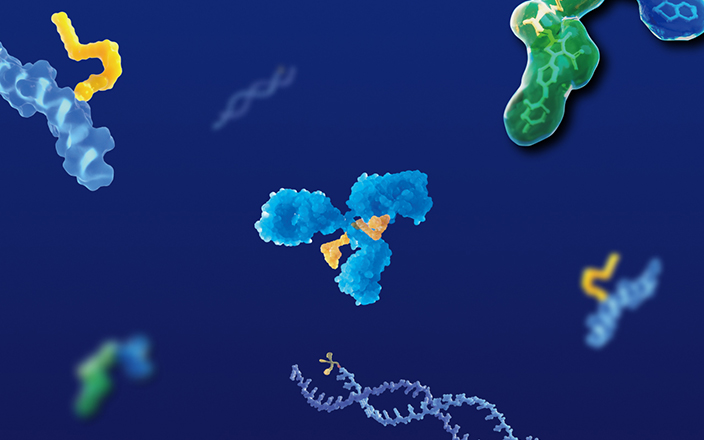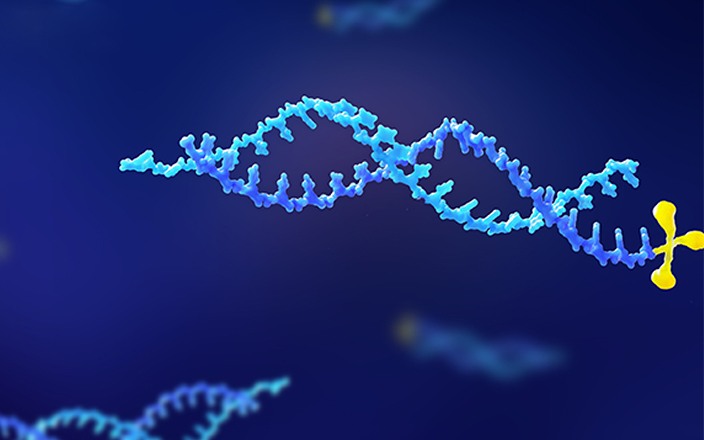Because of the variety of oligonucleotides and the diversity of chemical modifications and drug delivery techniques, it is essential to select an appropriate detection platform for pharmacokinetics (PK) analysis, drug metabolism, and tissue distribution assessment. Among these platforms, Ligand binding assays (LBA), such as hybridization-based enzyme-linked immunosorbent Assay (HELISA) and Meso Scale Discovery® electrochemiluminescence (MSD® ECL), offer high sensitivity and high throughput capabilities. These assays are widely used for quantitative analysis of oligonucleotides in biological samples, supporting preclinical and clinical PK studies of oligonucleotides.
What is LBA?
HELISA is a method of enzyme-linked immunosorbent assay based on complementary hybridization, which determines the concentration of the target oligonucleotide in the sample by qualitatively or quantitatively detecting the colored product. Similar to the HELISA workflow, the MSD®ECL method uses electrochemiluminescent labels to mark the nucleic acid probe and quantitatively measures the target oligonucleotides in the sample by detecting the intensity of the emitted light during electrochemical reactions. Based on the analytical principles, LBA can be categorized into specific steps: one-step, two-step, sandwich, double-bind, and competitive methods.
Why Choose LBA for the Quantitative Analysis of Oligonucleotide?
Advantages of the application of LBA in the quantitative analysis of oligonucleotide include:
High Sensitivity: HELISA easily offers low detection limits of 0.5 ng/mL and even lower limits of detection at 0.05 ng/mL with MSD®ECL. Moreover, MSD®ECL can simultaneously detect oligonucleotides at both high and low abundance levels, with a dynamic range spanning 4–5 orders of magnitude.
High Throughput: the HELISA method hardly requires sample pretreatment and chromatography-related linear injection methods, thus significantly reducing the detection time. Moreover, the utilization of automated equipment could reduce the handling time and manual pipetting errors, as well as increase sample throughput and the success rate of sample analysis.
Independence from Chemical Modifications and Delivery Systems: The HELISA method demonstrates better tolerance to chemical modifications of oligonucleotides.
What are the challenges of using LBA for the Quantitative Analysis of Oligonucleotide?
Probe Design: The capture and detection design of probes should essentially ensure proper affinity for the oligonucleotide analyte and minimize potential self-annealing. During the method development stage, screening of capture and detection probes is necessary. Additionally, optimizing the design of probes also contributes to improving the selectivity of the HELISA method.
Metabolite: HELISA lacks specificity for the target oligonucleotide in biological samples, making it hard to distinguish between the full-length oligonucleotide and long-chain metabolites such as n-1 and n-2. This could lead to cross-hybridization and overestimation of the concentration of the target oligonucleotide. Therefore, it is necessary to prioritize the use of LC–MS methods for metabolic stability studies and to select an appropriate HELISA method to reduce interference from metabolites on oligonucleotide analytes.
WuXi AppTec DMPK has developed two bioanalytical methods, based on HELISA and MSD®ECL, for quantitatively analyzing GalNAc-siRNA conjugated oligonucleotides in monkey serum samples. These methods have been methodologically validated to assess their specificity, selectivity, sensitivity, linear range, and accuracy. Assay results meet the regulatory requirements for CV% (±20%) and Bias% (±20%) and demonstrate that quantification of the AS in GalNAc-siRNA double-stranded structures using the MSD sandwich method is not affected by the presence of the SS.
With diverse bioanalytical platforms and extensive experience in oligonucleotide method development, we are capable of generating and delivering high-quality in vitro and in vivo data, thereby accelerating the drug development process.
If you want to learn more details about the use of LBA for DMPK Quantitative Analysis of Oligonucleotides, please read the article now.
Committed to accelerating drug discovery and development, we offer a full range of discovery screening, preclinical development, clinical drug metabolism, and pharmacokinetic (DMPK) platforms and services. With research facilities in the United States (New Jersey) and China (Shanghai, Suzhou, Nanjing, and Nantong), 1,000+ scientists, and over fifteen years of experience in Investigational New Drug (IND) application, our DMPK team at WuXi AppTec are serving 1,500+ global clients, and have successfully supported 1,200+ IND applications.
Talk to a WuXi AppTec expert today to get the support you need to achieve your drug development goals.
Related Services and Platforms




-

 DMPK BioanalysisLearn More
DMPK BioanalysisLearn More -

 Novel Drug Modalities DMPK Enabling PlatformsLearn More
Novel Drug Modalities DMPK Enabling PlatformsLearn More -

 Novel Drug Modalities BioanalysisLearn More
Novel Drug Modalities BioanalysisLearn More -

 Small Molecules BioanalysisLearn More
Small Molecules BioanalysisLearn More -

 Bioanalytical Instrument PlatformLearn More
Bioanalytical Instrument PlatformLearn More -

 PROTAC DMPK ServicesLearn More
PROTAC DMPK ServicesLearn More -

 ADC DMPK ServicesLearn More
ADC DMPK ServicesLearn More -

 Oligo DMPK ServicesLearn More
Oligo DMPK ServicesLearn More -

 PDC DMPK ServicesLearn More
PDC DMPK ServicesLearn More -

 Peptide DMPK ServicesLearn More
Peptide DMPK ServicesLearn More -

 mRNA DMPK ServicesLearn More
mRNA DMPK ServicesLearn More -

 Covalent Drugs DMPK ServicesLearn More
Covalent Drugs DMPK ServicesLearn More
Stay Connected
Keep up with the latest news and insights.















